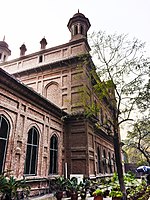
Pratap Singh Giani was a Sikh academic, scholar and calligraphist.

John Lockwood Kipling was an English art teacher, illustrator and museum curator who spent most of his career in India. He was the father of the author Rudyard Kipling.

The Lahore Museum is a museum located in Lahore, Punjab, Pakistan. Founded in 1865 at a smaller location and opened in 1894 at its current location on The Mall in Lahore during the British colonial period, Lahore Museum is Pakistan's largest museum, as well as one of its most visited ones.

The Punjab Province was a province of British India. Most of the Punjab region was annexed by the British East India Company on 29 March 1849; it was one of the last areas of the Indian subcontinent to fall under British control. In 1858, the Punjab, along with the rest of British India, came under the rule of the British Crown. It had a land area of 358,355 square kilometers.

Aitchison College is an independent, semi-private boys school for boarding and day students from grade 1–13 in Lahore, Pakistan. It has a tradition of providing an education that uses academics, sports, and co-curricular activities as tools for character development. The school follows a curriculum designed to culminate in the International General Certificate of Education and AS Level/A Level qualifications and is geared towards preparing students for university education. The institute is the only Pakistani school that is a member of the G30 Schools of the World. Aitchison has educated former Prime Ministers, including Imran Khan, Feroze Khan Noon and former President Farooq Leghari, lawyers, cricketers, and politicians.

Majha is a region located in the central parts of the historical Punjab region, currently split between the republics of India and Pakistan. It extends north from the right banks of the river Beas, and reaches as far north as the river Jhelum. People of the Majha region are given the demonym "Mājhī" or "Majhail". Most inhabitants of the region speak the Majhi dialect, which is the basis of the standard register of the Punjabi language. The most populous city in the area is Lahore on the Pakistani side, and Amritsar on the Indian side of the border.

Khalsa College is a historic educational institution in the northern Indian city of Amritsar in the state of Punjab, India. Founded in 1892, the sprawling 300-acre (1.2 km2) campus is located about eight kilometers from the city-center on the Amritsar-Lahore highway, adjoining Guru Nanak Dev University campus, to which Khalsa College is academically affiliated.
Guru Nanak founded the Sikh religion in the Punjab region of the northern part of the Indian subcontinent in the 15th century and opposed many traditional practices like fasting, Upanayana, idolatry, caste system, ascetism, azan, economic materialism, and gender discrimination.

Rai Bahadur Sir Ganga Ram was a British Indian civil engineer and architect. His extensive contributions to the urban fabric of Lahore, then in Pre-Independence India and now in modern Pakistan, caused Khaled Ahmed to describe him as "The Father of Modern Lahore".
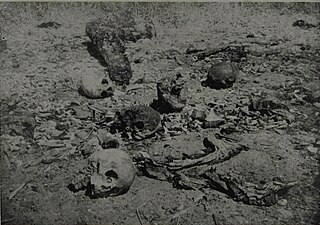
Chhota Ghallughara was a massacre of a significant proportion of the Sikh population by the Mughal Empire in 1746. The Mughal Army killed an estimated 7,000 Sikhs in these attacks while an additional 3,000 Sikhs were taken captive. Chhōtā Ghallūghārā is distinguished from the Vaddā Ghallūghārā, the greater massacre of 1762.
Religion in the Punjab in ancient history was characterized by Hinduism and later conversions to Jainism, Buddhism, Islam, Sikhism and Christianity; it also includes folk practices common to all Punjabis regardless of the religion they adhere to. Such practices incorporate local mysticism, including ancestral worship and worship of local saints of all faiths.
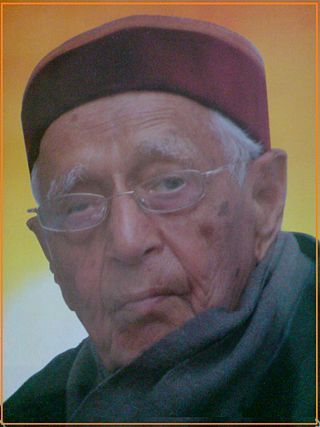
Thakur Ram Singh was a veteran Rashtriya Swayamsevak Sangh (RSS) pracharak from Himachal Pradesh, India, and the inspiration behind the Akhil Bharatiya Itihas Sankalan Yojana. He headed the Itihas Sankalan Samiti of the RSS. He was given the responsibility of leading the Akhil Bharatiya Itihas Sankalan Yojana in 1988. He started this work under the guidance of veteran RSS pracharak Moropant Pingle, who had a major role in founding this project.
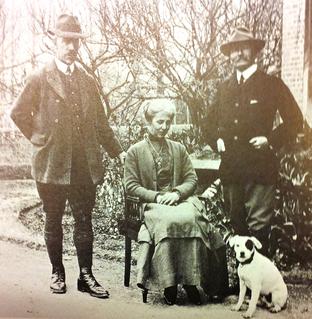
Frederick Henry Andrews (1866–1957) was a British educator and scholar noted especially for his catalogs of the Asiatic artifacts and manuscripts collected by the expeditions of Dr Aurel Stein. In the circle of close friends established at his household in Lahore, he was jocularly known as The Baron.
The following is a timeline of the history of the city of Lahore, Pakistan.
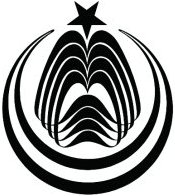
The National College of Arts, also referred as NCA, is a public art university located in Lahore, Punjab, Pakistan.
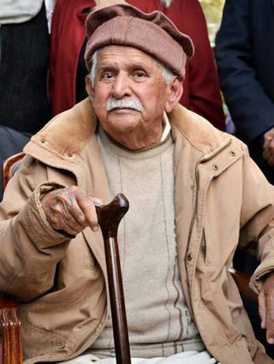
Khalid Iqbal was a Pakistani painter, art teacher and professor emeritus, appears known for landscape paintings as well as his natural forms paintings and portraits of Punjab, Pakistan.

Bishan Singh, also known as Baba Bishan Singh, was a Sikh painter whom achieved high-acclaim during his life. Much of his surviving works depicts scenes from the Sikh Empire and prominent figures of the era. His paintings have sold for large sums at auction.

Bhai Jawahir Singh Kapur was a leading figure of the Singh Sabha Movement, specifically the Lahore Singh Sabha. He was a social reformer, a civil worker, a poet, writer and proponent of the Khalsa Diwan (Lahore).





